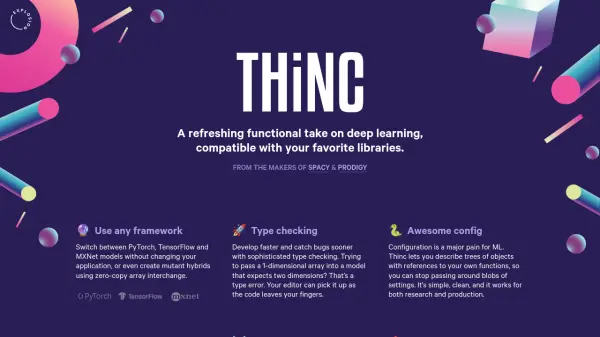What is PyTorch?
PyTorch emphasizes scalability with its `torch.distributed` backend, enabling efficient distributed training across multiple GPUs and machines. It integrates well with major cloud providers like AWS, Google Cloud, and Azure, offering easy scaling and deployment options. The framework is backed by a strong community and a rich ecosystem of libraries and tools, further extending its capabilities for various machine learning tasks. It requires Python 3.9 or later for the latest versions.
Features
- Production Ready: Seamlessly transition between eager and graph modes with TorchScript and accelerate production paths with TorchServe.
- Distributed Training: Scalable distributed training and performance optimization enabled by the `torch.distributed` backend.
- Robust Ecosystem: Rich ecosystem of tools and libraries (like Captum, PyTorch Geometric, skorch) extending PyTorch for computer vision, NLP, and more.
- Cloud Support: Well-supported on major cloud platforms (AWS, Google Cloud, Microsoft Azure) for frictionless development and scaling.
- Flexible Installation: Options to install via Conda, Pip, LibTorch (C++/Java), or from source for various operating systems and compute platforms (CPU, CUDA, ROCm).
- ExecuTorch: End-to-end solution for enabling on-device inference capabilities across mobile and edge devices.
Use Cases
- Developing deep learning models for research.
- Deploying machine learning models into production environments.
- Training large-scale models using distributed computing.
- Building computer vision applications.
- Creating natural language processing systems.
- Enabling on-device AI inference for mobile and edge applications.
- Interpreting machine learning models.
- Applying deep learning techniques to graph-structured data.
FAQs
-
What are the prerequisites for installing the latest PyTorch versions?
The latest versions of PyTorch require Python 3.9 or later. Depending on your package manager, you might also need prerequisites like NumPy. -
What is ExecuTorch?
ExecuTorch is a component of the PyTorch ecosystem providing an end-to-end solution for enabling efficient on-device inference capabilities across mobile and edge devices. -
Can PyTorch be used with languages other than Python?
Yes, PyTorch provides C++ and Java bindings through LibTorch, allowing integration with applications written in these languages. -
What is the PyTorch Foundation?
The PyTorch Foundation is a project of The Linux Foundation that supports the PyTorch open-source project, guiding its development and fostering the community.
Related Queries
Helpful for people in the following professions
PyTorch Uptime Monitor
Average Uptime
99.7%
Average Response Time
94.63 ms
Featured Tools
Join Our Newsletter
Stay updated with the latest AI tools, news, and offers by subscribing to our weekly newsletter.











